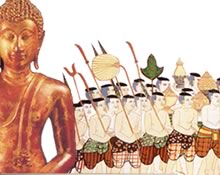 |
 |
|
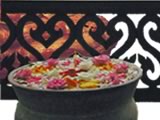 
 |

|

Thai
Travel Diary
A
six-and-a-half-hour flight from Tokyo-- where the cherry blossoms
had already started blooming in mid-March -- landed me in the
middle of a hot Thai summer. In Bangkok, the temperature was over
35ûC degrees. I was there for a two-week field trip to search
for handcrafts suitable for promotion in Japan.
No
doubt about the Thai heat
Thailand
shares its border with Malaysia, Myanmar, Laos, and Cambodia,
and as this fact has affected the development of the race and
culture of the country, so it is also strongly reflected in the
handcrafts. Our trip was a JETRO mission to the three cities of
Nan, Chiang Mai and Bangkok and surrounding villages, where we
inspected samples of dyed and woven textiles, bamboo and other
grass crafts, and handmade paper.
The Thais are a gentle people always bowing and greeting you with
their hands clasped in front of them as if in prayer. I found
it hard to get used to this form of greeting at first but soon
found myself doing the same and feeling very natural about it.
The language kind of slides off the tongue in soothing ripples,
but I found it hard to understand. Just memorizing "Thank-you"
was an effort. It is no wonder that they say the Thai language
is one of the hardest in the world. "Thank-you" in women's language,
by the way, is pronounced "corpkun-car," but the phrase I made
most use of was "lon mak mark" -- It's hot!
Though historically the Thai people may have reason to feel resentment
towards Japan, during the two weeks I was there I realized how
strongly they count on aid from Japan. What with the recent decline
in exports to Japan, they seemed particularly keen to do whatever
they can to create products that the Japanese people want to buy.
Take a look at my shots of the old city of Chiang Mai which has
really changed in the last ten years, and of Bangkok, where Japanese
cars make up a large proportion of the vehicles in the traffic
jams.
|
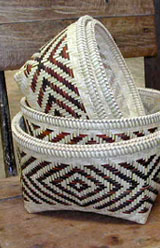

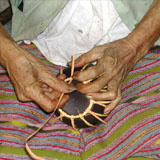
|
|


Handcrafts
out of grass
In
and around the small town of Nan in Northern Thailand live the
Hmongs and Miens people. We visited a village where they weave
baskets and mats from grass fiber. People of all ages, from children
to the elderly were gathered under one roof working avidly. They
have a cooperative system which organizes the procurement of materials
and the distribution of work. There is also an NGO engaging the
village people in all sorts of activities to try and prevent an
exodus to the cities. The same NGO has set up a shop in Bangkok
especially for the sale of their handcrafts. In the village we
visited the people were only weaving the main part of the basket.
People in another village made the handles, and in another village,
they assembled the final product. I wish I could have spoken more
to the weavers to hear their side of the story but local people
seemed too shy to talk to the foreigners.
In another town, we found women skilfully binding the lids of
pots with twine. Unlike China where the entire pot is often bound,
here most of the pot was left exposed in the typically warm Thai
way.
|


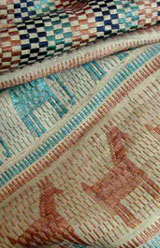
|
|
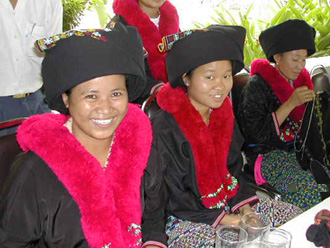

A
rich textile tradition
Of
all the handmade crafts we saw on this trip, the most diverse
and exquisitely made were the textiles. Each region, tribe, and
village has their own colors, patterns, and weaving techniques.
Women from the Mien tribe wearing intricately cross-stitched costumes
and large hats took three hours to ride to where we were on their
motorbikes to show us their work. There is a wide variety of textiles
in the area, from ones in subtle natural dyes to the eye-catching
red and green stripes. The fibers also range from cotton to silk
and hemp or ramie. Most are made as men's sarongs or formal wear
for women. Indigo is also popular, and we saw some new innovations
such as paste-resist dyed fabrics with appliqued accents.
Wherever we went it seemed to be the women who were working. They
organized study groups for the preservation of traditional techniques
and were also passionate about cultivating new markets. We hardly
ever saw men at work, which struck us as very odd.
|


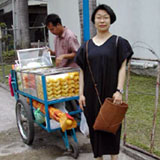


|
|
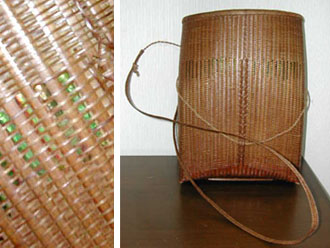

Bamboo
weaving
The
Thai people have amazing techniques for splitting bamboo into
the finest possible strips for weaving. The techniques are easily
on a par with the best Kyoto basket weavers. In fact, we heard
that these Thai baskets are exported to Japan and sold at Tokyo
prices. In the hotel shops in Thailand we saw some baskets where
they had gone to the trouble of adding a silk linings but the
best bags for summer were the simple ones made only from bamboo.
Our favorites were some rather unusual shoulder bags which have
a greenish sheen on about a third of the surface -- probably from
the wings of Christmas beetles or the like. The effect is subtle
and proof of a very sophisticated technique. The bags had the
air of something made by a highly skilled craftsman who really
enjoys his work. One of our members, Ms Akiko Hino who has a wholesale
crafts business, posed for me with one of the bags beside a street
vendor. Don't you think she looks almost like a local?
Another of our favorites was a basket for keeping fish shaped
like some sort of animal. There is a lid so that the fish can't
jump out. It made me want to put wildflowers in it.
|
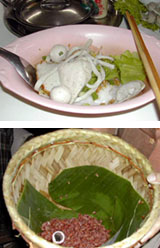 
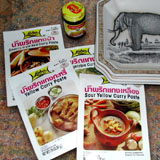 
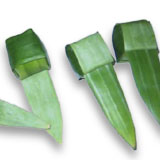
|
|
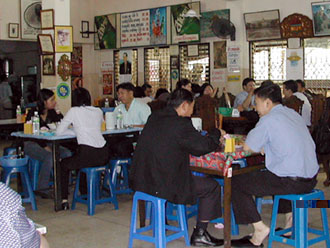

Yes,
Thai cooking is hot
While
traveling in the countryside, we always ate at eateries along
the roadside -- simple foods like rice noodles, including the
local favorites. Eating with a spoon in the right hand and a fork
in the left, the Thai people like to eat their noodles very spicy,
making the soup almost red with hot pepper sauce. You could have
your noodles served with meat balls or wontons too. Needless to
say, after five days of this kind of hot noodle lunch I was craving
some familiar Japanese flavors.
A Thai-style hotpot that we ate at the Isetan Department Store
in Bangkok had about 40 different ingredients to choose from ranging
from meat balls to prawns and squid and you could flavor the soup
according to your own taste with the local hot sauce, fragrant
vegetables and herbs or the nam pla fish sauce. The best dish
we had anywhere was the genuine Tum Yum Kung that we ate at the
Sukhothai Hotel in Bangkok. The juicy prawns and the scent of
the lemon grass really put us in a Thai mood. We were so busy
eating there was no time for photos so there are no shots of this
meal.
I wanted my friends back home to try the real taste of Thailand,
so I bought some packages of soup stock and spices at the supermarket.
They all look incredibly hot.
At the hotel restaurant, they served us red rice from a bamboo
basket lined with banana leaves individually onto our plates.
These little touches made us feel we were in Thailand. It was
rather like visitors to Japan being served from a traditional
wooden rice container and server at an authentic Japanese inns.
At food stalls on the sidewalk we found sweets made of coconut
soaked in honey wrapped in long leaves. We were most impressed
by the way the leaves were woven so neatly.
|
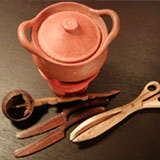

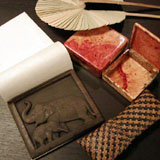
|
|
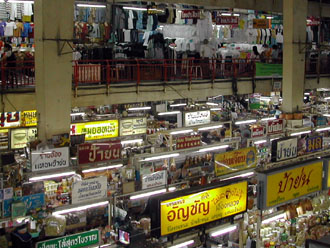

Asian
markets a treasure box of miscellany
In
the markets of Asia, you find merchandise everywhere piled to
the ceiling-- an energy unique to this part of the world. In Thai
markets we also found sections overflowing with household goods
and food. Handmade objects such as unglazed soup pots and ladles
made from coconut shells were simple but full of warmth. I was
a little disappointed to hear that these kinds of objects are
being used less and less by the Thai people in the cities.
Now that we have completed our mission, products are to be designed
for the Japanese market based on the results of our observations.
Look out for news of an upcoming exhibition.
(April 2002, Yuko Yokoyama)
|
(C)Copyright
2002 Jomon-sha Inc, All rights reserved.
|
þ@
|
 |
 |

